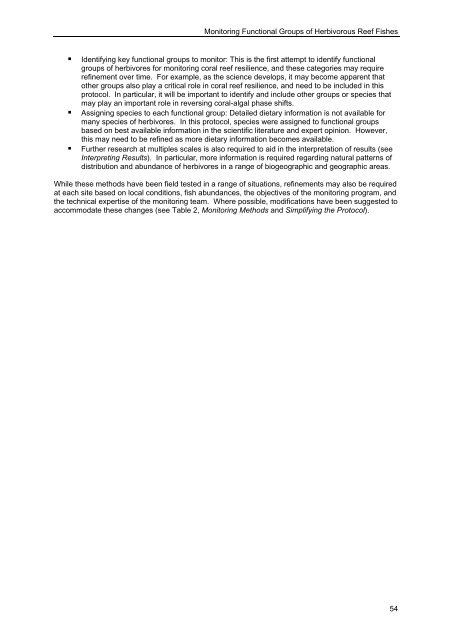Green2009-herbivore monitoring
Green2009-herbivore monitoring.pdf
Green2009-herbivore monitoring.pdf
Create successful ePaper yourself
Turn your PDF publications into a flip-book with our unique Google optimized e-Paper software.
Monitoring Functional Groups of Herbivorous Reef Fishes<br />
• Identifying key functional groups to monitor: This is the first attempt to identify functional<br />
groups of <strong>herbivore</strong>s for <strong>monitoring</strong> coral reef resilience, and these categories may require<br />
refinement over time. For example, as the science develops, it may become apparent that<br />
other groups also play a critical role in coral reef resilience, and need to be included in this<br />
protocol. In particular, it will be important to identify and include other groups or species that<br />
may play an important role in reversing coral-algal phase shifts.<br />
• Assigning species to each functional group: Detailed dietary information is not available for<br />
many species of <strong>herbivore</strong>s. In this protocol, species were assigned to functional groups<br />
based on best available information in the scientific literature and expert opinion. However,<br />
this may need to be refined as more dietary information becomes available.<br />
• Further research at multiples scales is also required to aid in the interpretation of results (see<br />
Interpreting Results). In particular, more information is required regarding natural patterns of<br />
distribution and abundance of <strong>herbivore</strong>s in a range of biogeographic and geographic areas.<br />
While these methods have been field tested in a range of situations, refinements may also be required<br />
at each site based on local conditions, fish abundances, the objectives of the <strong>monitoring</strong> program, and<br />
the technical expertise of the <strong>monitoring</strong> team. Where possible, modifications have been suggested to<br />
accommodate these changes (see Table 2, Monitoring Methods and Simplifying the Protocol).<br />
54


















